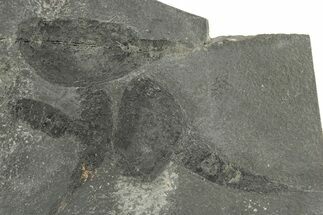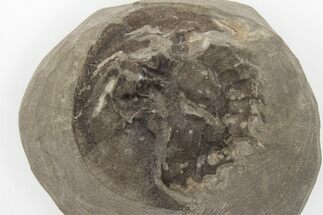This Specimen has been sold.
Rare, 6.4" Silurian Phyllocarid (Ceratiocaris) Fossil - Scotland
This is a rare Silurian-aged Phyllocarid (Ceratiocaris papilio) collected in Scotland. It's 6.4" in length and is exceptionally well preserved on a nice section of shale. It comes with an acrylic display stand.
About Phyllocarids
Phyllocarids are an extinct group of marine arthropods that thrived from the Cambrian to the Devonian period, with some surviving into the Carboniferous. They belong to the subclass Phyllocarida within the class Malacostraca, which includes modern crustaceans like lobsters, shrimp, and crabs. Phyllocarids are characterized by their unique body structure, which includes a bivalve-like carapace that covered the head and thorax, giving them a shrimp-like appearance. This carapace is often smooth but can exhibit ridges or spines, depending on the species.
Their segmented abdomen extends beyond the carapace, ending in a fan-like tail structure called a telson, which is flanked by smaller appendages known as uropods. The carapace helped protect their front limbs, which they used for feeding, while their back limbs were likely adapted for swimming and maneuvering in the water. They are thought to have been filter feeders, scraping detritus or small particles of food from the water column.
Fossils of phyllocarids are relatively rare, but they provide valuable insights into the evolution of crustaceans and other arthropods. Their remains are often found in marine sediments, especially in locations where fine-grained rock has preserved their delicate structures.
Phyllocarids are an extinct group of marine arthropods that thrived from the Cambrian to the Devonian period, with some surviving into the Carboniferous. They belong to the subclass Phyllocarida within the class Malacostraca, which includes modern crustaceans like lobsters, shrimp, and crabs. Phyllocarids are characterized by their unique body structure, which includes a bivalve-like carapace that covered the head and thorax, giving them a shrimp-like appearance. This carapace is often smooth but can exhibit ridges or spines, depending on the species.
Their segmented abdomen extends beyond the carapace, ending in a fan-like tail structure called a telson, which is flanked by smaller appendages known as uropods. The carapace helped protect their front limbs, which they used for feeding, while their back limbs were likely adapted for swimming and maneuvering in the water. They are thought to have been filter feeders, scraping detritus or small particles of food from the water column.
Fossils of phyllocarids are relatively rare, but they provide valuable insights into the evolution of crustaceans and other arthropods. Their remains are often found in marine sediments, especially in locations where fine-grained rock has preserved their delicate structures.
SPECIES
Ceratiocaris papilio
LOCATION
Lesmahagow, Lanarkshire, Scotland
FORMATION
Kip Burn Formation
SIZE
6.4" long on 5.2 x 4.8" rock
CATEGORY
SUB CATEGORY
ITEM
#113112
We guarantee the authenticity of all of our specimens.
 Reviews
Reviews










